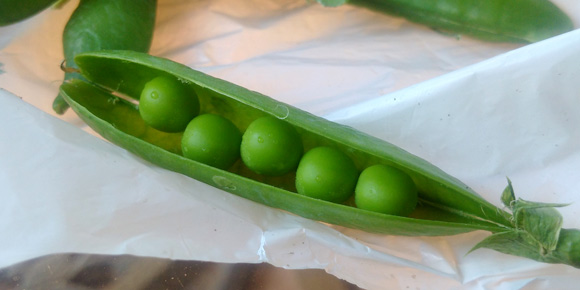Technically and botanically, peas are a fruit, because their seeds are developed from the ovary of the pea flower. But nobody eats them as fruit, although sugar snap peas are very sweet. Sugar snap peas are a cross between common garden peas and snow peas. They are not only sweet, they are crunchy – the perfect mange-tout, French for “eat it all”.
The botanical name for peas is Pisum sativum. Fresh shelled green peas from the pod are semi-mature seeds, which we eat boiled or steamed. The hard peas we use for soups are the ripe, dried yellow or green seeds that are split in half, hence split peas.
Peas are a cold weather plant and can be sown directly outdoors when the soil temperature reaches about 7 degrees, usually about four to six weeks before the last spring frost. Plant the hard, round peas about an inch deep and two inches apart. For faster germination, soak them overnight and plant them in a raised (hence slightly warmer) bed. Keep the beds moist, but not wet. Mulching can help. Give them a trellis or some string to climb on to keep the fruit off the ground. You may have to help them get started.
Aphids and powdery mildew are the two biggest problems. Aphids can be knocked off with the spray for a hose. Good air circulation will help to keep mildew at bay.
Pea flowers are equipped with both male and female parts and are perfectly capable of self-pollinating. This takes place inside the pretty white flower before it even opens. The resulting seed, the pea, can be 0.1 to 0.36 of a gram in weight.
Garden peas need to be cooked and eaten as soon as possible after picking. As time goes on, the peas inside the pod become mealy and mushy. Something that also happens if left on the vine too long.
Peas contain protein and vitamins
Most people like peas. The Latin phrase, Manducandum pisum elit necesse est, non vivere, (Eating pea soup is necessary, living is not necessary) probably says it all. Peas contain a lot of protein, a huge dose of vitamin C as well as vitamins B6, K, phosphorous, magnesium, copper, zinc and lutein. 100 grams of dried split peas contain 25 grams of protein. They also contain eight grams of sugar (starch) but to balance that off, the same amount delivers 26 grams of fibre.
A few people are allergic to peas. These are likely to be the same folks who are allergic to peanuts, soy and beans, all legumes. The most common symptom is an itchy skin rash.
Nitrogen fixers
We are often told that legumes such as peas are nitrogen fixers, but what does this mean? Legumes enjoy a symbiotic relationship with rhizobia bacteria that live in the root zone. They invade the root and multiply, forming nodules where they feed on nutrients and energy from the plant and in the process release nitrogen in a form the plant can use. On peas, the nodules are round and can become the size of a pea. They are replaced regularly during plant growth as the plant begins to send its energy to the development of its fruit. If a plant demonstrates poor growth and is light green, it maybe be a lack of native rhizobia in the soil.
Boiling or steaming peas breaks down cell walls making nutrients more available to humans. Peas are one vegetable that handle freezing very well and are a great addition to many dishes to give them a touch of glamour.
The British like to cook peas with a big handful of mint – delicious. Another favourite English dish is peas porridge, made from split peas, a little water, salt and pepper and perhaps some additional seasoning with a ham hock or bacon. Its consistency is like that of porridge. For those who don’t know or can’t remember the rhyme:
Pease porridge hot, pease porridge cold.
Pease porridge in the pot, nine days old.
Some like it hot, some like it cold,
Some like it in the pot, nine days old!
Sweet pea is another order of plant
Sweet pea, Lathyrus odoratus, is another order of plant all together. They are grown only for their beautifully scented flowers. Don’t eat them. Sweet peas can be quite toxic to people, leading to scurvy-like symptoms including loose skin.
Dorothy Dobbie is the owner of Manitoba Gardener magazine. Her weekly radio show can be heard on CJNU, 93.7 FM on Sunday mornings at 8:00. For subscriptions to Manitoba Gardener, call 204-940-2700 and Jane will help you, or go to localgardener.net.



